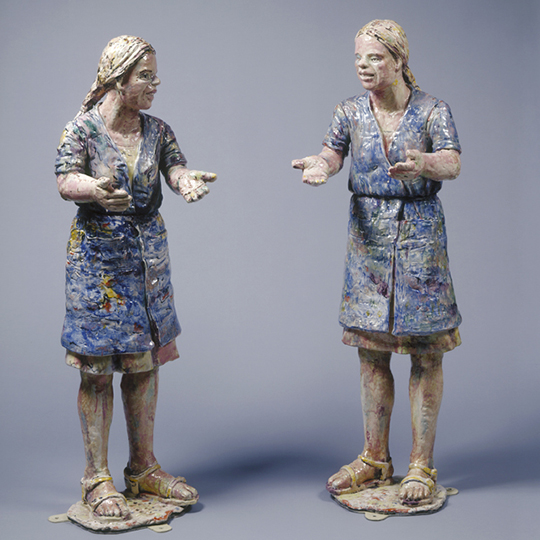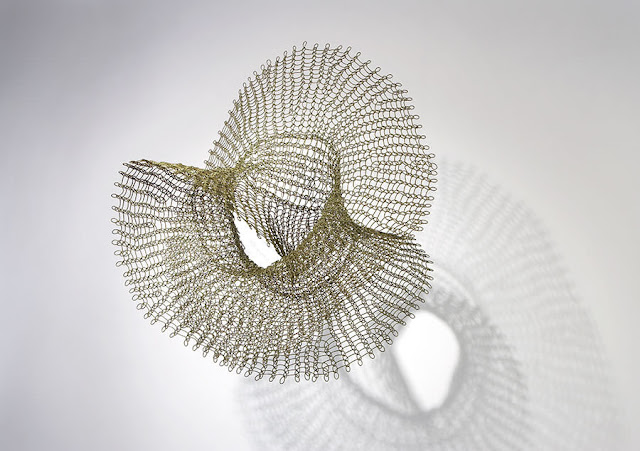
Viola Frey was a star of the California art scene for five decades. She used ceramic pottery techniques to create monumental human figures with a funky, unpretentious look. She became successful in the 1970s, and enlivened the art scene in the Bay Area for 3 decades. She was also a popular educator and community figure in Oakland.
When Viola started her career in the 1960s, the art community in the Bay Area, was charged with creative energy. The big new idea in sculpture was that ceramics could be used to create works of art, instead of merely utilitarian tableware. In prior decades, terra cotta had been used for busts and other small pieces, but California sculptors were using ceramic techniques—including firing and glazing—to create representational figures.
The second big idea of the time was Funk: it was okay for art to be comical, antic, ironic and junky. This is a pretty radical thought—artists had traditionally striven toward excellence and refinement—and it hasn't spread much beyond California. Funky ceramic sculpture is very friendly and unassuming, comfortable with its own crudeness. Here's an example by the most famous sculptor to use ceramic.
 |
| Robert Arneson California Artist, 1982 SFMOMA / Jan's photo |
With extensive training in traditional ceramics, and having studied ceramics as an art-form in a pioneering art school on the east cast, Viola was an important leader in the development of funky, figurative ceramics. Her most famous works were over-size figures of people from her childhood—not particular people so much as types. Their postures and expressions seem stiff and puzzling, but their surface is a riot of expressionist brushwork. Using clay figures as a background for expressionistic painting was one of Viola's unique innovations.
Background: A native Californian, Viola grew up on her family's vineyard in Lodi, California. It would be interesting to know something about her family and how she got interested in art.
Training: After high school, Viola attended college in nearby Stockton, but she soon got a scholarship to attend the California College of Arts and Crafts, from which she received a BFA in 1956.
After that Viola enrolled in graduate school at Tulane University in New Orleans, but she soon dropped out in order to attend a new school for clay arts in Port Chester, New York, one of the earliest venues on the East Coast geared toward exploring ceramics as a fine art medium without the functional constraints of craft.
Personal life: One of Viola's instructors in ceramics at CCAC, Charles Fiske, strongly supported her work and became her life partner. Viola lived and worked in Oakland, moving a few times to get more studio and storage space. Viola died at the age of 71 in Oakland, California, in 2004.
Viola got her start as an artist in 1965 when she was hired as Artist Potter in Residence by California College of Arts and Crafts in Oakland, her alma mater. By 1971 she was a full-time assistant professor in the Ceramics Department, and she was able to quit her day job. Soon she was able to buy her own home in Oakland, which had a large studio space.
Viola's sculptures started growing taller, sometimes reaching nearly 12 feet. It was unprecedented to use clay for monumental works, and it required her to develop whole new techniques. Sculptures were built and fired in segments of a size she or her assistant could lift, and the segments were pieced together like a jigsaw puzzle. Since they couldn't bear their own weight, each work had a poured concrete interior. Their gigantic size reduces the viewer to the size of a pre-teen, lost in a wilderness of huge, inscrutable adults.
Throughout her career—from the 1970s through the 1990s—Viola exhibited regularly, traveled the world to expand her art practice, and received numerous awards.
Examples
 |
| Pink Lady, 1965 Oakland / Jan's photo 2014 |
 |
| Double Self, 1978 Ceramic and glaze, life-size violafrey.org |
 |
| Man Observing II, 1984 de Young / Jan's photo, 2017 |
 |
| Homage, 1985-1987 ceramic and glazes / about 8 feet long di Rosa / violafrey.org |
 |
| Ethnic Man, 1991 Utah / Jan's photo, 2013 |
 |
| Falling Man in Suit, 1991 Internet |
 |
| The World and The Woman, 1992 ceramic and glazes almost 12 feet long violafrey.org |
 |
| American Nude Series (Woman with Elbow on Raise Knee), 1994 Glazed ceramic OMCA Photo by Dan L. Smith, 2010 |
 |
| Family Portrait, 1995 ceramic and glazes About 7' x 7' violafrey.org |
 |
| World Civilization, 1999 SFO Museum, Boarding Area A / from their website |
 |
| Internet grab |





















































